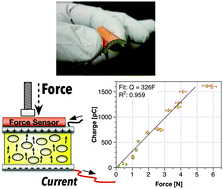Molecularly-doped polyurethane foams with massive piezoelectric response†
Abstract
We report flexible piezoelectric polyurethane foams with d33 piezocoefficients up to 244 ± 30 pC N−1. Polymer foams have large volume changes under applied force, and dipole-doped polymers can have large polarizations even when poled at fields two orders of magnitude lower than space-charge electrets. Combining these features results in piezocoefficients an order of magnitude higher than conventional polymer piezomaterials, and independent selection of matrix and dopant should permit easy processing and tailorable properties. We further motivate the use of mesostructured materials by noting that the theoretical piezocoefficient limit is much higher for such materials than for conventional ceramics or polymers.



 Please wait while we load your content...
Please wait while we load your content...